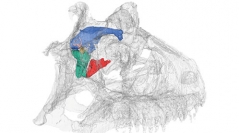

 Comptes Rendus Palevol
18 (8) - Pages 985-995
Comptes Rendus Palevol
18 (8) - Pages 985-995The endocranial morphology of the abelisaurid Carnotaurus sastrei, from the Upper Cretaceous of Patagonia, is studied using X-ray Computed Tomography (CT). The CT scans provided information that allowed the first reconstruction of the brain, inner ear and braincase pneumaticity for this South American taxon. The endocranial morphology confirms that abelisaurids share an overall conformation of the brain and inner ear. However, some traits, such as the height of the dorsal sinuses and the length of the flocculus in the cranial endocast, and a large subsellar recess in the basicranium, appear to characterize the South-American abelisaurids only. Moreover, the olfactory acuity of Carnotaurus resembles that reported for other abelisaurids (e.g., Majungasaurus, Viavenator), suggesting that the sense of smell had an important role. However, some attributes of the endocranial features of Carnotaurus (i.e. development and orientation of the olfactory bulbs and tracts) may imply particular olfactory capacities when compared with other abelisaurids.
Abelisauridae, paleoneurology, reptile encephalization quotient, pneumaticity, Cretaceous